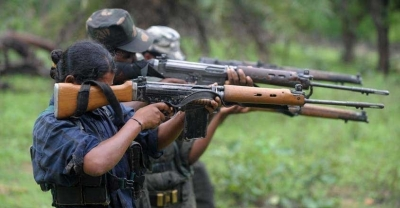New Delhi — The decades-long Naxalite movement appears to be in its final stages, with officials suggesting that the insurgency could collapse well before the official deadline of March 31, 2026. Based on the recent wave of large-scale surrenders, security agencies now estimate that the movement may end by January 2026, possibly around Republic Day.
Security forces currently hold a decisive upper hand, and according to senior officials, even those insurgents still resisting surrender are likely to be neutralised by early next year. The once-sprawling area of Naxalite operations has been significantly reduced, allowing for targeted and more precise counter-operations.
At present, Bijapur, Sukma, and Narayanpur districts in Chhattisgarh remain the only major strongholds. In regions such as Gariaband, Kanker, and Dantewada, Maoist numbers have dwindled drastically, suggesting that more surrenders are imminent.
Over the past three days alone, around 300 Naxalites have surrendered along with their weapons. While many have been neutralised in encounters, the recent string of voluntary surrenders marks a turning point. The clearest indication of the movement’s collapse came when Venugopal alias Bhupati, a senior Naxalite commander known for orchestrating several deadly attacks, laid down arms.
Venugopal’s surrender triggered internal discord among the remaining cadres. In a letter following his decision, he admitted the futility of continuing the fight, writing: “If we do not surrender, we will be overwhelmed by the security forces. The best option is to give up arms and surrender.”
Currently, only three top leaders remain active — Misir Bear, Thippari Tirupati, and Ganpati. Officials estimate the remaining cadre strength at 250–300 members. However, their morale is at an all-time low due to weak leadership, scarcity of weapons and ammunition, and the fact that many are now fighting under duress rather than ideology.
These remaining fighters are primarily focused on protecting their leaders rather than engaging security forces, aware that resistance would likely lead to their deaths. Officials expect that many of them, too, will eventually surrender, having realised that the battle is lost.
The focus of ongoing operations is on a key battalion stationed along the Chhattisgarh–Telangana border, believed to be sheltering the remaining top leadership. Once this group is neutralised, authorities anticipate a cascade of further surrenders.
Union Minister for Coal and Mines G. Kishan Reddy said the recent mass surrenders reflect the growing trust of the people in the government’s efforts to restore normalcy in affected regions. He credited the success to the Modi government’s developmental initiatives and firm resolve to eradicate Left-Wing Extremism.
While the end of the movement seems imminent, intelligence agencies remain cautious, monitoring the activities of urban sympathisers who might attempt to revive or propagate the ideology. “The movement on the ground may end soon, but we must ensure that the ideology fades with it,” a senior Intelligence Bureau official noted.
He added that although some fringe elements may try to keep the ideology alive, “it is highly unlikely that they will find any significant traction.”
With inputs from IANS





